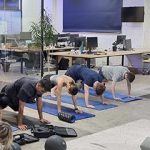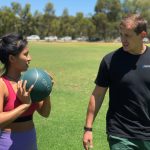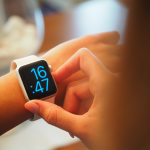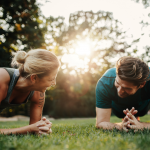Gladys Burill, the oldest woman to complete a marathon at an age of 92
(credit: http: www.worldrecordacademy.com)
Hi Readers,
Today, we’re focusing on something that Functional For Life are truly passionate about – encouraging exercise at all ages.
It’s no secret the body changes over time, and it’s a touchy subject that can be highly complex when broken down into fine detail. It’s also important to acknowledge that we can improve our health at any age, vastly through fitness and lifestyle choices.
Again this is an incredibly complex topic and the below is designed for you to consider where you sit with your physical activity at this point in time.
We hope it will prompt you to think about what you currently do and if you need to make any lifestyle changes.
Remember, every human is unique and these are some of the general physiological changes that can occur. HOWEVER, many of these processes can be dramatically slowed or stopped in their tracks with a regular exercise program. For extra information on how exercise can improve health, check out this outstanding video below by Dr. Mike Evans.
To support the video, we’ve compiled the following facts around exercising over the age of 50 from the Better Health Channel on the Victorian State Government website.
The physical decline of older age
About half of the physical decline associated with ageing may be due to a lack of physical activity. Without regular exercise, people over the age of 50 years can experience a range of health problems including:
Reduced muscle mass, strength and physical endurance
Reduced coordination and balance
Reduced joint flexibility and mobility
Reduced cardiovascular and respiratory function
Reduced bone strength
Increased body fat levels
Increased blood pressure
Increased susceptibility to mood disorders, such as anxiety and depression
Increased risk of various diseases including cardiovascular disease and stroke.
Common myths
Many older people believe that exercise is no longer appropriate. Some of the common misconceptions that prompt older people to abandon physical activity include:
Older people are frail and physically weak.
The human body doesn’t need as much physical activity as it ages.
Exercising is hazardous for older people because they may injure themselves.
Only vigorous and sustained exercise is of any use.
Other barriers to exercise
Other factors that may contribute to the lack of physical exercise among people over 50 years include:
Some older people may have a preference for sedentary activities, such as reading and socialising.
The relatively high cost of some sports may exclude some people.
Many sports and activities tend to attract young adults, so older people may feel unwelcome.
The physical fitness marketplace has failed to include and attract older people.
Benefits to the older body
Some of the many benefits of regular exercise for older people include:
Muscle – the amount and size of muscle fibres decreases with age. Some studies suggest that the average body loses around 3kg of lean muscle every decade from middle age. The muscle fibres that seem to be most affected are those of the ‘fast twitch’ (phasic) variety, which govern strength and speedy contraction. There is evidence to suggest that these changes are related to a sedentary lifestyle, rather than age. Muscle mass can increase in the older person after regularly exercising for a relatively short period of time.
Bone – bone density begins to decline after the age of 40, but this loss accelerates around the age of 50 years. As a result of this bone loss, older people are more prone to bone fractures. Exercise may help to reduce the risk of bone loss and osteoporosis. Weight-bearing exercise, in particular, helps to keep bones healthy and strong.
Heart and lungs – moderate intensity exercise is most favourable: for example, exercising at about 70 per cent of the individual’s maximum heart rate (220 beats per minute minus your age). Studies show that cardiorespiratory fitness takes longer to achieve in an older person than a young person, but the physical benefits are similar. Regardless of age, people are able to improve their cardiorespiratory fitness through regular exercise.
Joints – the joints of the body require regular movement to remain supple and healthy. In particular, people with arthritis can benefit from aerobic and strengthening exercise programs.
Body fat levels – carrying too much body fat has been associated with a range of diseases including cardiovascular disease and diabetes. Regular exercise burns kilojoules, increases muscle mass and speeds the metabolism. Together, these physiological changes help an older person maintain an appropriate weight for their height and build.
Getting active
Suggestions include:
If you are over 40 years, obese, suffer from a chronic illness or have been sedentary for some time, see your doctor before you start a new exercise routine.
Choose activities you find interesting. You are more likely to keep up with an exercise routine if it’s fun rather than a chore.
Exercise with friends. Make physical activity an enjoyable social occasion.
Safe, easy and comfortable forms of exercise include walking, swimming and cycling.
Weight training can increase your muscle mass – programs as short as six to eight weeks can be beneficial.
Start off slowly and aim for small improvements. Keep track of your progress in a training diary for added motivation.
Check your pulse frequently to make sure you aren’t overdoing it.
Choose appropriate clothing and safety gear.
Don’t let yourself dehydrate – drink plenty of water.
You will find more information and suggestions in the Australian Government’s physical activity guide for older Australians: Choose Health: Be Active.
People with chronic illnesses
Some older people have chronic illnesses (such as severe arthritis, osteoporosis or advanced cardiovascular disease) that limit their choice of physical activities. In these situations, it is best to consult closely with your doctor, physiotherapist or health care professional to devise an exercise program that is healthy and safe.
Pre-exercise screening is used to identify people with medical conditions that may put them at a higher risk of a experiencing a health problem during physical activity. It is a filter or ‘safety net’ to help decide if the potential benefits of exercise outweigh the risks for you. Print a copy of the pre-exercise screening tool and discuss it with your doctor or exercise professional.
After more advice?
If you are interested in training but unsure where to start, feel free to email us on [email protected].
We would be more than happy to pass on some free advice to guide you in the right direction. If you would like additional information from elsewhere please consider the following:
Your doctor
Physiotherapist
Australian Physiotherapy Association Tel. (03) 9091 0888
Seniors Information Victoria Tel. 1300 135 090
We will leave you with three of many amazing achievements people have made later in life:
Gladys Burrill: Completed a marathon at the age of 92.
Yuichiro Miura: Climbed Mount Everest at the age of 80.
Pavel Rezvoy: Rowed across 3000 miles of the Atlantic Ocean at the age of 67.
We do not believe age is a barrier to exercise! We encourage everyone to look into how they can incorporate physical activity into their day to day life. Thanks for reading and stay tuned for more training tips and advice!
References:
Better Health Channel/Victoria State Government 2017, Physical Activity for Seniors, https://www.betterhealth.vic.gov.au/health/healthyliving/physical-activity-for-seniors, viewed January 5 2018.
Warning: The training and instructional content contained on this website should be taken as information and not medical advice. Please consult your health professional before attempting these exercises.






